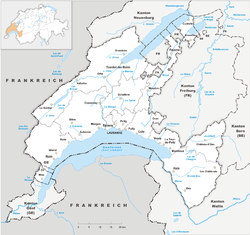Canton de Vaud
| Canton de Vaud | ||
|---|---|---|
| Canton of Switzerland | ||
|
||
 Location in Switzerland |
||
| Coordinates: 46°37′N 6°33′E / 46.617°N 6.550°ECoordinates: 46°37′N 6°33′E / 46.617°N 6.550°E | ||
| Capital | Lausanne | |
| Largest City | Lausanne | |
| Subdivisions | 339 municipalities, 10 districts | |
| Government | ||
| • Executive | Conseil d’État (7) | |
| • Legislative | Grand Council (150) | |
| Area | ||
| • Total | 3,212.03 km2 (1,240.17 sq mi) | |
| Population (12/2015) | ||
| • Total | 773,407 | |
| • Density | 240/km2 (620/sq mi) | |
| ISO 3166 code | CH-VD | |
| Highest point | 3,210 m (10,531 ft): Diablerets | |
| Lowest point | 372 m (1,220 ft): Lake Geneva | |
| Joined | 1803 | |
| Languages | French | |
| Website | VD.ch | |
The Canton of Vaud (French pronunciation: [vo]) is the third largest of Swiss cantons by population and fourth by size. It is located in Romandy, the French-speaking western part of the country, and borders the canton of Neuchâtel to the north, the cantons of Fribourg and Bern to the east, Valais and Lake Geneva to the south, the canton of Geneva to the south-west and France (Bourgogne-Franche-Comté) to the west.
The capital and biggest city is Lausanne, officially designated "Olympic Capital" by the International Olympic Committee and host to many sport organizations. The canton had 725,944 inhabitants as of 2011[update].
Along the lakes, Vaud was inhabited in prehistoric times. Later, the Celtic tribe of the Helvetii inhabited the area. The tribe was defeated by Caesar's troops in 58 BC and as a consequence the Romans settled the area. The towns of Vevey (Latin: Viviscus) and Lausanne (Lausonium or Lausonna) are two of the many towns established by the Romans.
In 27 BC the state of Civitas Helvetiorum was established around the capital of Avenches (Aventicum). There are still many Roman remains around the town today. Between the 2nd and the 4th century the area was repeatedly invaded by Alemannic tribes, and in the 5th century the Burgundians occupied the area. The Merovingian Franks later replaced the Burgundians. Their occupancy did not last long either, and in 888 the area of the canton of Vaud was made part of the Carolingian Empire. In 1032 the Zähringens of Germany defeated the Burgundians. The Zähringens themselves were succeeded in 1218 by the counts of Savoy. It was only under the counts of Savoy that the area was given political unity, establishing the Barony of Vaud. A part stretching from Attalens to the River Sarine, in the north, was absorbed by the canton of Fribourg.
...
Wikipedia


